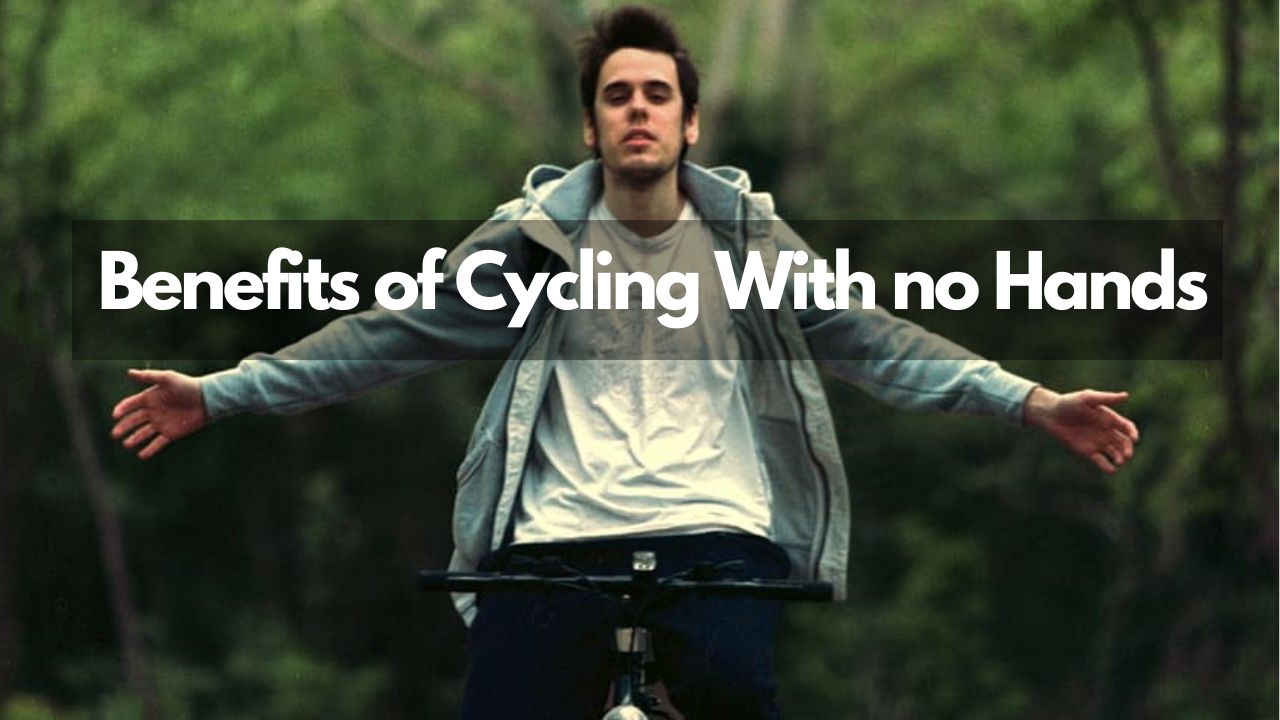Cyclify India is reader-supported! We may receive an associate commission if you purchase through one of the Amazon Associate links on this page! Continue Reading…
When I was little, I remember being proud of the fact that I could ride a bike without using my hands (Look Ma, no hands!). However, it was years decades ago, and for some reason, compared to now, riding a lightweight road bike felt much simpler.
You can no longer ride the bike hands-free as it veers or wanders. To stop an accident, you need to swiftly seize the handlebar.
It takes a lot of patience and skill to ride without using your hands. Failure to do so might result in catastrophic harm. We’ll look at the Benefits of Cycling with No Hands in this post today.
Experts often ride without using their hands while changing clothes, eating while riding, and taking care of other necessities. And the greatest ones get to do it that is, without using their hands as soon as they cross the finish line.
Many people mistakenly believe that riding a bicycle without hands is a showy or recreational activity, but that isn’t the case. Ultimately, this strengthens our core muscles, builds confidence & bike handling abilities, and above all makes us feel more a part of our bikes.
Possessing this expertise will serve you well in many different contexts. Check out this detailed explanation on “How to ride a bicycle without hands” and “What are the benefits of cycling with no hands.”
Table of Contents
5 Stunning Benefits of Cycling with No Hands:

1. Easy to Consume and Refuel
In cycling events, riding a bike without hands is quite popular since it’s easier to eat & drink while racing. Due to the fact that you can consume energy bars and drink water faster with this riding talent, you will be stronger than your opponent.
2. Makes Your Muscles Stronger
Yes, cycling without using your hands strengthens your core muscles and enhances your ability to handle a bike. As you practiced this talent, you also gained a great deal of confidence.
3. Advantages of Dressing & Undressing
It is occasionally necessary to undress or dress while cycling in races. You can put on and take off garments based on temperature and save valuable time if you are proficient at riding a bike without using your hands.
4. Practical Ability: Not for Show Off
The misconception that hand-cycles are just for show is unfounded. It increases our self-esteem, strengthens our core, and improves our ability to handle a bike.
Forming a biker organization in your community will allow you to instruct rookie riders in riding techniques and launch your cycling career. In this manner, a rookie rider might begin making money and pursue a career in riding.
5. Helps You Become an Independent Rider
It indicates that you are missing something crucial if you are not proficient in this ability. A raincoat is optional, as is pulling back long hair. With this ability, nothing can prevent you from riding.
How to Ride With No Hands: A Comprehensive Guide

Step 1: Picking the Correct Path
On busy, uneven, and reliable roads, it wouldn’t be an excellent plan to practice. Find a peaceful, level, smooth, and quiet place to work.
Step 2: Acquire One-Handed Practice
If you want to learn to ride a bike without using your hands, you need to build up your confidence before you can consider befriending speed as your friend as it’s gonna help you maintain balance. Try this with one hand instead first:
After placing one hand on the handlebars, place the second one there and swap it out. As a result, you are utilizing each hand separately. In this manner, you can cover the brakes in case you need to apply pressure.
Note: Keep in Mind that applying pressure to the brakes quickly or forcefully will not assist you in balance. This is especially true for the front brake.
Step 3: Hovering
Simply said, hovering is the act of using your fingers to keep a steady equilibrium while cycling. Experiment once more and again. After a little while, take your hands off of them and grip them with your fingers once more.
Hold on to your bars if you find yourself becoming unsteady. Continue repeating this until you reach a comfortable point, at which point go to the next phase.
Step 4: The Real Deal
You are now prepared to remove your hands from the bars. Having said that, quickness is your friend and will enable you to maintain a little more equilibrium.
Simply unwind, sit upright on the bike, and focus ahead rather than downward at the handlebars or pedals.
To ride a bike, you need to have both feet flat on the ground and your hands gently on the handlebars. Remove your hands from the bars as soon as they are no longer as heavy, then sit up straight and face ahead. Maintain your composure and maintain a straight, at-ease appearance.
Select the ideal bike of any kind to do hands-free cycling on both gears and regular cycles!
Step 5: As smoothly as possible, pedal
To avoid wobbles, cycle as smoothly as you can. Work on your “souplesse,” which involves making almost perfect circles with your feet. You’ll discover that this increases your steadiness and control.
Always maintain your weight over the saddle, and be ready to re-learn the technique on each new bike (as well as geometry).
A Step-by-Step Guide to Cycling Without Hands: See, Ma, no hands!
Tips for Riding a Bike Without Using Your Hands
- Examine your bike first. Non-hands riding might be challenging sometimes because of inadequate equipment maintenance rather than bad skill. If you want to hone this ability, you should do it using a bike that is in good working order.
- Riding without hands might be challenging. if the front wheel wobbles, the headset is binding, or the fork is misaligned. Crooked bike tracks are made by these creatures. When it’s the bike’s fault, some people who can’t seem to grasp this ability get angry at their perceived clumsiness.
- Practice. Utilize a vacant parking lot or another area free of vehicles. (Due of the uneven surface and rolling resistance, this is not a skill that should be learned on a green field.) Keep your speed moderate—don’t go too slowly. Riding without hands is more manageable at speeds of at least 12–15 mph (19–24 kph).
- Sit squarely on the saddle while holding the bar top. Sit up straight and lower your arms when you’re ready. Instead of hesitantly leaning forward and keeping your hands lingering above the bar as if you were sleepwalking, be ready to seize it with the least movement.
- Maintain your balance and return of weight. Recall that you steer with your hips & weight moves even when you’re holding onto the handle. Well, it is now true. In order to change the bike’s line, spin fluidly and slightly shift your hips. You’ll pick it up very soon, I’ll wager. Numerous hands-free bikers are adept at maneuvering their cycles around obstacles as well as through curves.
- Unwind & Relax. As is typical with riding a bike, everything functions best when your body is relaxed and flowing. Tiny flaws diffuse rather than intensify. A bike takes on a life of its own when it’s tense.
- Use caution when driving. Skilled riders may unplug their jackets, take off their arm warmers, clean their sunglasses, or just sit back & peel an energy bar. Riders in ultramarathons can receive a complete meal from a support vehicle.
However, keep in mind that riding without hands is perilous by nature. The brake and handlebar levers are far away from your hands, which could be occupied. Choose your places, which are often areas that are level and free of bumps.
It’s difficult to use no hands in a strong crosswind, and quite dangerous in a windy one. Hold off till the wind is in your favor. If you have to go no-hands in a group, wait until you’re in the rear so that no one else will be negatively impacted by your error.
Safety Advice for Hands-Free Cycling
Although riding a bicycle without hands is dangerous, there are safety guidelines and safeguards that a novice should follow.
- If you are going to fall or have an accident, you need to wear a helmet. Helmets are highly important safety equipment.
- Examine the state of the road where you plan to practice. Always choose less congested, calm highways.
- Choose the ideal full-sleeve garment to help avoid major injuries.
- Remember to always wear protective gloves.
- You should not move at an excessively rapid or sluggish pace.
- Carry everything you need with you, including the water bottle.
Common Questions on Advantages of Hands-Free Cycling
Q1. Is bike riding difficult without hands?
No, it isn’t challenging. It takes a lot of practice to ride without hands. Try balancing the handlebars with your fingertips after placing your entire weight on the seat. One by one, rotate each hand. Release the handlebars and begin riding as soon as you are comfortable.
Q2. Does being hands-free when riding a bike help with balance?
Undoubtedly, riding a bicycle without assistance may greatly enhance one’s strength, confidence, and balance. In bicycle events, it is more often utilized.
Q3. Is it against the law to ride a bicycle without hands?
While there is nothing unlawful about it, you shouldn’t do this on busy roadways like flyovers and motorways. Since bikers are subject to the same traffic laws as drivers, you should always abide by them.
Final Thoughts on the Benefits of Cycling with no Hands
It takes a lot of time and effort, guys, to acquire a new talent. Without a doubt, you won’t learn it in ten minutes. It can take more than a day, a few days, a week, or even a month, but if you practice consistently, you will eventually succeed.
Guys, riding a bicycle without hands has some very amazing perks .I really hope you took away a lot from this.
Liked: How Do 15 Minutes of Cycling Every Day Help Your Health? Your life will be changed by these incredible advantages!


0 Comments